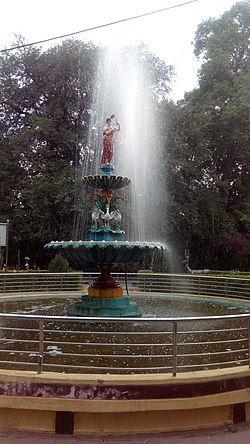Gulab Bagh and Zoo
| Gulab Bagh and Zoo | |
|---|---|
| city | |
 |
|
| Location in Rajasthan, India | |
| Coordinates: 24°34′17″N 73°41′34″E / 24.57139°N 73.69278°ECoordinates: 24°34′17″N 73°41′34″E / 24.57139°N 73.69278°E | |
| Country |
|
| State | Rajasthan |
| District | Udaipur |
| Elevation | 598 m (1,962 ft) |
| Languages | |
| • Official | Hindi |
| Time zone | IST (UTC+5:30) |
| Telephone code | 0294 |
Gulab Bagh (Sajjan Niwas Garden) is the largest garden in Udaipur, Rajasthan, India. It is spread over 100 acres (40 ha) of land. The garden has innumerable varieties of roses. Gulab Bagh gets its name from the abundance of rose flowers it has.
Gulab Bagh is an old Sub-City Level Park, having lush green campus and several places of attraction including ponds, library, zoological park, temples and several government offices. It houses 12 Bovri’s, 5 tubewells, 1 large pond (Kamal Talai – under rejuvenation), 1 zoological park, couple of temples – Arya Samaj, Hanuman, Dargah etc. and a range of Government offices like 2 forest offices, 2 PHED offices, 1 PWD office, 1 library etc. The park has 4 entrance gates, which are designed artistically as old masonry structure. Out of 4, only 2 gates are open for general public. There is appropriate parking facility is available at 2 operational entry gates, and it can currently accommodate 350 two wheelers and 50 car parking inside the park. The entire park is surrounded by a boundary wall, 3–5 m in height and made of mix of concrete, stone and brick.
Gulab Bagh, also known as Sajjan Niwas Garden, was built by Maharana Sajjan Singh in the 1881. It is the fourth oldest zoo in the semi-continent. It spans across 66 acres of land, and is hailed as one of the most beautiful and largest garden in Rajasthan. By Maharana's volition, a horticulturist from Madras, T.H. Story, was appointed in 1882 to stock the garden with plants with medicinal values on the 66.5 acres of land and worked there till 1920. The garden consisted of a Lotus Pond, and many prominent trees that included many species of mangoes, guava, grapes, lemon, bor, mulbury, rayan, pomegranate, bananas, sapota, tamarind, bullock’s heart (ramphal), lichi, arjun trees, wood apple, karonda, campher, citron, jamun, pummelo, meetha neem, kargi lime, ficus species, anola, jack fruit, dhanverjia, grandi flora, jasmin, dawood etc. In the year 1882, all the trees had their name-plates denoting Hindi, English, and systematic botanical names, which are not the same now. A small pond existed in the garden before it was demolished for the construction of Water works complex. In this pond a water lily, Victoria sp., was initially planted. The leaf of Victoria could withstand a child on a chair kept on it, a property common to all the water-lilies of the genus due to plant's structure.
The Garden draws it name as Gulab Bagh due to the presence of a ranch where variety roses can be found in abundance. The garden was also called Bada Bagh but the name dropped has out of popular use.
Maharana Sajjan Singh placed the foundation stone of the Victoria museum(now called Saraswati Bhawan Library) in the garden on 2 November 1890. It was inaugurated by Lord Lansdown. Mr. Gauri Shankar Ojha was the first curator of this museum appointed in the year 1890. The museum had many rare artefacts and stone manuscripts dating from 3rd Centaury B.C. to 17th Centaury A.D.
...
Wikipedia


